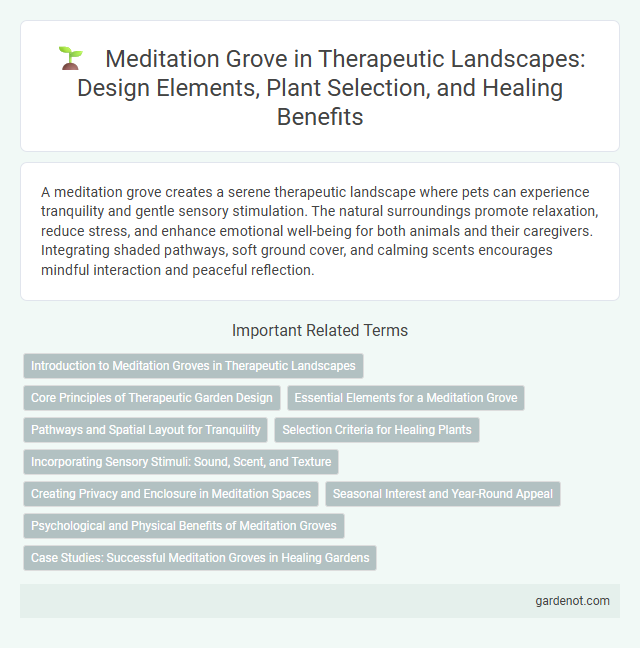A meditation grove creates a serene therapeutic landscape where pets can experience tranquility and gentle sensory stimulation. The natural surroundings promote relaxation, reduce stress, and enhance emotional well-being for both animals and their caregivers. Integrating shaded pathways, soft ground cover, and calming scents encourages mindful interaction and peaceful reflection.
Introduction to Meditation Groves in Therapeutic Landscapes
Meditation groves are carefully designed natural spaces within therapeutic landscapes that promote mindfulness, relaxation, and mental well-being. These groves often feature dense vegetation, tranquil pathways, and seating areas to encourage reflective practices and stress reduction. Incorporating elements like native plants and water features enhances the sensory experience, supporting emotional healing and cognitive restoration.
Core Principles of Therapeutic Garden Design
Meditation groves embody core principles of therapeutic garden design by integrating natural elements that promote mental restoration and stress reduction. These spaces emphasize sensory engagement through the use of soothing plant textures, gentle sounds, and calming scents to foster mindfulness and emotional balance. Strategic layout and accessibility ensure inclusivity, allowing diverse users to experience tranquility and healing within a cohesive, nature-based environment.
Essential Elements for a Meditation Grove
A meditation grove requires essential elements such as secluded natural settings, soft ground coverings like moss or grass, and gentle soundscapes created by rustling leaves or flowing water to enhance mental calmness. Incorporating diverse plant species with soothing colors like greens and purples supports visual relaxation and promotes mindfulness. Accessibility through winding paths and strategically placed seating areas encourages prolonged meditation sessions and overall therapeutic benefits.
Pathways and Spatial Layout for Tranquility
Meditation groves are designed with winding pathways that encourage slow, mindful walking, enhancing relaxation and mental clarity. The spatial layout often incorporates natural elements such as trees, water features, and open clearings, creating zones of solitude and reflective spaces. These intentional designs promote a sense of tranquility by fostering connection with nature and facilitating meditation practices.
Selection Criteria for Healing Plants
The selection criteria for healing plants in a meditation grove prioritize species with calming scents, proven stress-reducing properties, and non-toxic characteristics to enhance mental well-being. Native plants such as lavender, chamomile, and rosemary are favored for their therapeutic effects and adaptability to the local climate. Ensuring biodiversity and seasonal variation supports continuous sensory engagement and sustained healing benefits throughout the year.
Incorporating Sensory Stimuli: Sound, Scent, and Texture
Meditation groves integrate sensory stimuli such as calming natural sounds, aromatic plants, and varied textures to enhance therapeutic landscapes. Soft rustling leaves, gentle water features, and fragrant blossoms like lavender stimulate auditory and olfactory senses, fostering mindfulness and relaxation. Diverse tactile elements, from smooth stones to rough bark, engage touch, creating a multisensory environment that supports mental well-being.
Creating Privacy and Enclosure in Meditation Spaces
A meditation grove enhances therapeutic landscapes by using dense vegetation and natural barriers to create privacy and enclosure, fostering a sense of safety and introspection. Strategically placed trees, shrubs, and layered planting forms a secluded environment that minimizes external distractions and noise. This design approach promotes mental clarity and emotional calm essential for effective meditation practices.
Seasonal Interest and Year-Round Appeal
Meditation groves offer seasonal interest through vibrant spring blooms, lush summer foliage, and tranquil autumn colors, creating a dynamic sensory experience that enhances mindfulness and relaxation. The incorporation of evergreen plants and thoughtful design elements ensures year-round appeal, providing a consistent, serene environment for meditation throughout changing weather conditions. These therapeutic landscapes promote mental well-being by connecting individuals to nature's cycles and fostering a peaceful retreat space in all seasons.
Psychological and Physical Benefits of Meditation Groves
Meditation groves provide a serene natural environment that significantly reduces stress and anxiety, promoting improved mental health and emotional well-being. These green spaces enhance concentration and mindfulness by immersing individuals in calming sensory experiences that foster relaxation and cognitive restoration. Regular use of meditation groves supports physical health by lowering blood pressure, reducing cortisol levels, and encouraging gentle physical activity through mindful walking or sitting.
Case Studies: Successful Meditation Groves in Healing Gardens
Successful meditation groves in healing gardens demonstrate significant improvements in patient well-being by providing tranquil natural environments that reduce stress and promote mindfulness. Case studies from facilities like the Mayo Clinic and the Cleveland Clinic reveal lower cortisol levels and enhanced recovery times in patients exposed to these serene green spaces. Integrating native plants, water features, and shaded seating areas creates a multisensory experience that supports emotional healing and mental clarity.
Meditation grove Infographic

 gardenot.com
gardenot.com